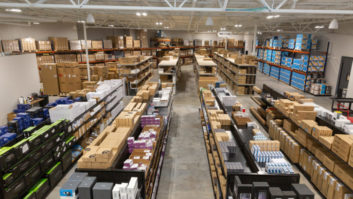TWICE: How is business so far this year?
Liz Cutting, imaging director, The NPD Group: As we look
at year-to-date sales at the end of May compared to the same time last year,
technologies including IT, CE and imaging, and excluding mobile phones and
video game hardware and software, sales have been basically flat in terms of
dollars. But we’re in an amazing spot
right now because if you look at cameras alone, we’re actually up in revenue by
7 percent. All of that growth at this
time is driven by detachable-lens cameras.
If you look at the detachable-lens segment, we’re up in dollars by 31
percent. Certainly we had a tough year last year, but compared to other
categories, things are looking very good for detachable-lens cameras, and even
some compact-camera segments.
The economy has a lot to do with this. Those who are more
affluent are back investing in the [camera] market. If you look at
detachable-lens penetration in May, the d-SLRs were at 12 percent penetration
in 2009, 11 percent in 2010. When you look at those who earn $75,000 or more,
against a base of d-SLR penetration of 11 percent, we have an
affluent-household penetration of 22 percent, so that’s where we’re really
seeing the growth. That’s why I think
there’s a lot of room for growth and opportunity this year in both
detachable-lens cameras as well as advanced compact cameras.
Accessories go along with
that. Certainly we’ve seen a 23 percent
increase in dollars in camera accessories like lenses, tripods and
flashes.
Overall, the household penetration of compacts is pretty
saturated. We were at 75 percent in
2009, 73 percent in 2010, which is interesting.
Price is the No. 1 decision factor across most cameras segments,
but when you look at cameras over $300, price becomes the fifth most important
thing, features, brand trust is second, then performance, then latest
technology, then price.
David Lee, senior VP, Nikon: For our company we continue
to look at what the consumer is looking for.
We continue to see excellent sales in our D3000 and D5000 entry-level
d-SLR cameras, the consumer is very comfortable with that form factor at this
point in time in the U.S., but where we see a lot of growth and opportunity
this year is in long-zoom point-and-shoot cameras. The people that are coming
in as repeat buyers really seem to be going in that direction, as well as to
touchscreen models, so on and so forth. That’s driving a lot of our business
this year.
Chuck Westfall, consumer imaging products technical advisor,
Canon USA: The detachable-lens category has certainly been the most
pleasant sight for us to see. The bounce back from 2009 has been impressive
especially in the first half. We’ve done very, very well with the EOS lineup.
The Rebel T2i is a good example and also the 7D and 5D. But I think the other
thing that goes along with that are accessory sales, especially the lenses and
speed lights. All of those are good
profit builders and good add-ons to the sale.
Ron Gazzola, marketing and operations VP, Fujifilm North
America: We’ve had great success the
first half and saw a lot of market share growth with our long-zoom S-series
cameras, like our S2700 and S1800. We’ve
also had great success with our adventure category, the XP10, doing very well. As
we look to the second half, I think those areas will continue to see great
results because we think that consumers will be coming back for that long-zoom
feature set and the XP10 active-use camera for the family.
The Z70 has been a great camera for us in terms of that
fashion-oriented, gift-giving item, which always seems to do really well at the
holidays. So those are three key areas
for us that we’ll continue to address in the back half.
Richard Campbell, digital imaging marketing director, Samsung:
We had an interesting approach to the market through the introduction of
our DualView cameras last year. We had a
tremendous amount of success with our launch.
Certainly it was sort of an “ah-ha” moment, putting an LCD on the front
of the camera to allow consumers to take pictures differently. The success
carried over into the spring of this year, and we’ve supported the category
with our Alicia Keyes ad campaign this quarter, and the consumers have really
adapted to it. It’s helped with ASPs
[average selling prices]. Certainly,
consumers are willing to step up for that type of feature and benefit. And our
products with the touchscreens have fueled a lot of our business and helped
fill a niche that hasn’t been met by a product in the marketplace.
Mark Weir, digital imaging senior technical manager, Sony
Electronics: Price sensitivity is something that’s a given for
consumers. You read any of the
syndicated research, and that is certainly in the top three of their
consideration set when they’re purchasing.
However, I do think that the push for added value, particularly
addressing the demands of the repeat customer, is in many ways going to give
customers opportunities to purchase products that they wouldn’t otherwise have
been attracted to. A lot is changing in digital imaging right now, the
emergence of different form factors, the emergence of interchangeable-lens
cameras in new areas, the emergence of new feature sets … We think that is
going to attract customers to purchase better products, more expensive
products, and we think that is going to somewhat temper the decline in ASPs
that we typically see in the back half of the year.
Dennis Eppel, merchandising VP, Panasonic: The opportunity
that we see in the compact size is really the long zoom, so you know our
business is doing exceptionally well when you get to the higher zooms and the
compact cameras.
Mark Sherengo, sales and marketing director, Pentax Imaging: I
agree that price in niche segments will be important to the back half. We
understand our role at Pentex has been as a niche player, and we also realize
that photography is a personal choice.
We go out after that unique customer.
The color-SLR for example – Our K-x introductory-level SLR has been a
great success for us. We’ve out sold our expectations globally on that product
and will continue that in the back half with some new launches. We’re going to
stick with the theme of photography being personal. Our W90, which is an
11th-generation adventure-proof camera, has done excellently for us, and we
expect that to continue into the back half of the year.
We have to constantly answer the question why Pentax. We have to
help the end users to see themselves using our product, and that’s what we’re
going to focus on.
Pete Palermo, product marketing director, Eastman Kodak: The
primary focus for us this year is on post-capture. So, we hear time and time
again from consumers, “Make it easy for us to get video and stills off my
camera and make it easy for me to do things with those pictures and videos.” So
consumers who are in the market, especially for our products, are looking for
products that make it easier for them to share and relive those moments. So
second-time buyers, third-time buyers, are less focused necessarily on
megapixels and zoom ratio and now see the importance of LCD size and post
capture attributes. So quality of the LCD, ease of use in terms of on-camera
review, sharing and so forth are key elements in our lines.









